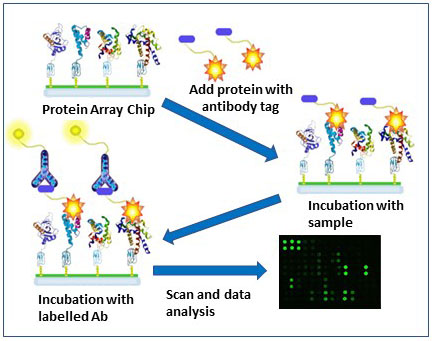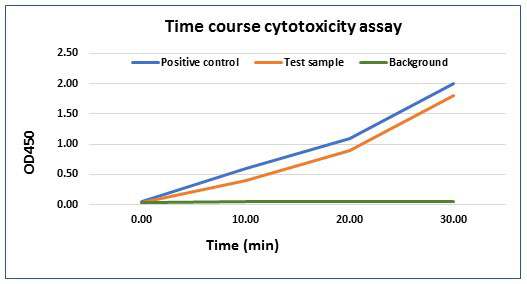ELISA-Protein Array Cytotoxicity Assay
Enzyme-linked Immunosorbent Assay (ELISA)
ELISA assay is considered as the gold standard colorimetric immunoassay assay for detecting and quantifying specific analytes in complex biological samples. ELISA has been used as a diagnostic tool in medicine, clinical trials, food allergens, cell culture, plant pathology, and quality-control check in various applications. APAF uses a robotic platform epMotion for liquid delivery on the assay plates for precision and reproducibility (Figure 1). ELISA is suitable for studies that involve limited target antigens but large number of samples.

Figure 1. A typical standard curve for an ELSIA assay. Liquid delivery was performed using the epMotion robotic platform.
Literature
- Coban, M., et al. The Association of Fibroblast Growth Factor 23 with Arterial Stiffness and Atherosclerosis in Patients with Autosomal Dominant Polycystic Kidney Disease. Kidney Blood Press Res. 2018, 43:1160-1173. doi: 10.1159/000492244.
- Li, D., et al. Association of Parkinson's disease-related pain with plasma interleukin-1, interleukin-6, interleukin-10, and tumour necrosis factor-α. Neurosci Lett. 2018, pii: S0304-3940(18)30500-7. doi: 10.1016/j.neulet.2018.07.027.
- Chebotareva, N., et al. Heat shock protein 70 and anti-heat shock protein 70 antibodies in patients with chronic glomerulonephritis. Cell Stress Chap. 2018, doi: 10.1007/s12192-018-0928-8.
Protein Array
Protein array is a versatile high-throughput assay platform used for identifying interactions of hundreds of proteins in parallel, as well as determining their functions. Many target proteins are spotted on a glass slide; probe molecules, typically labelled with a fluorescent dye, are added to the array, and any fluorescent signal emits is captured by a laser scanner (Figure 2). Protein microarrays are rapid, economical, highly sensitive, and require small volume of samples. APAF offers various protein array services such as cancer auto-antibody array, autoimmune disease IgG auto-antibody arrays, allergen protein arrays, antibody specificity profiling, protein-protein interaction profiling, etc.

Figure 2. An illustration of Protein Array assay.
Literature
- Melton, L. "Protein arrays: Proteomics in multiplex". Nature. 2004, 429 (6987): 101–107. doi:10.1038/429101a.
- Hall, D.A., Ptacek, J., and Snyder, M. "Protein Microarray Technology". Mech. Ageing Dev. 2012, 128: 161–7. doi:10.1016/j.mad.2006.11.021.
- Lee, J.R., et al. Emerging protein array technologies for proteomics. Expert Rev. Proteomics. 2013, 10:65-75. doi: 10.1586/epr.12.67.
Cytotoxicity Assay
Cytotoxicity assay is a colorimetric, non-radioactive assay for measuring induced cytotoxicity. This assay is based on measurement of activity of lactate dehydrogenase (LDH). LDH is a stable enzyme usually found in the cytosol of all cells, but rapidly released into the supernatant when plasma membrane is damaged (Figure 3). Cytotoxicity assay is being used in the drug discovery and clinical trials, cell culture, stem cell culture, endotoxin testing and drug toxicity. Further it has been used in detection and quantification of cell-mediated cytotoxicity, determination of mediator-induced cytolysis, determination of cell death in bioreactors, etc. and in the food, cosmetic, clinical and pharmaceutical industries.

Figure 3. Typical results for LDH Cytotoxicity Assays.
Literature
- Zou, X., et al. Renal scattered tubular-like cells confer protective effects in the stenotic murine kidney mediated by release of extracellular vesicles. Sci. Rep. 2018, 8:1263 doi: 10.1038/s41598-018-19750-y.
- Li, G., et al. Hypothermia exerts early neuroprotective effects involving protein conjugation of SUMO-2/3 in a rat model of middle cerebral artery occlusion. Mol. Med. Rep. 2017, 16:3217-3223 doi: 10.3892/mmr.2017.6994.
- Smith, S.M., et al. A simple protocol for using a LDH-based cytotoxicity assay to assess the effects of death and growth inhibition at the same time. PLoS One. 2011, 6:e26908 (2011). doi: 10.1371/journal.pone.0026908.
Sample Request Forms
These maybe found at our Forms, Terms and Conditions page
